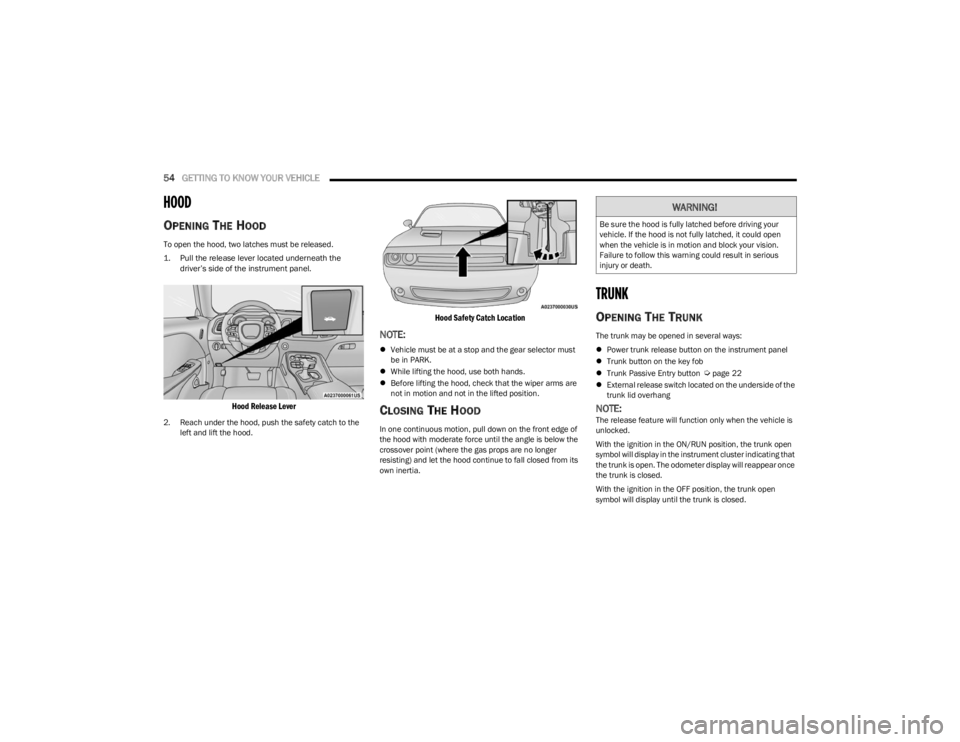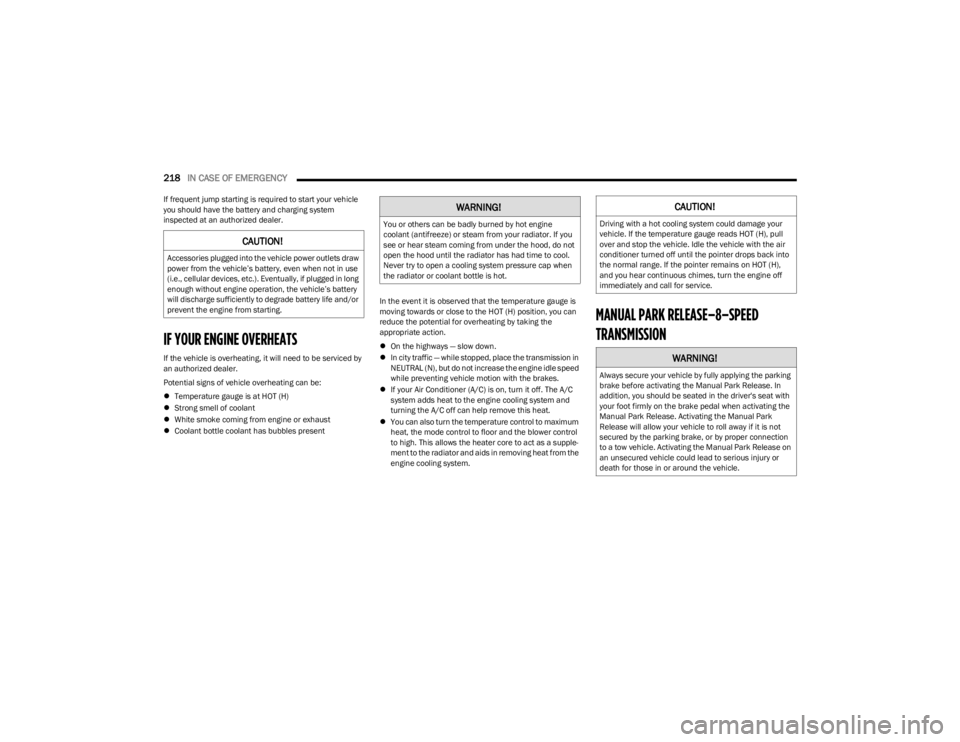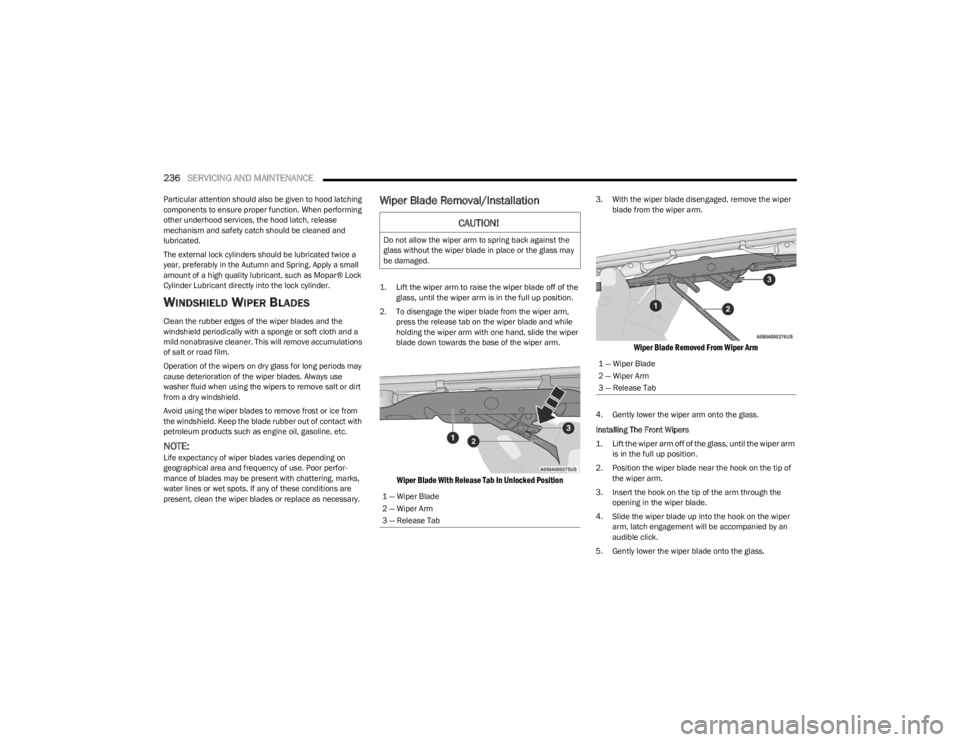2023 DODGE CHALLENGER hood release
[x] Cancel search: hood releasePage 19 of 300

GETTING TO KNOW YOUR VEHICLE17
NOTE:
When opening the driver's door with the ignition in
ON/RUN (engine not running), a chime will sound to
remind you to place the ignition in the OFF position.
In addition to the chime, the message will display
“Ignition Or Accessory On” in the cluster.
For more information on proper engine starting
procedures, see
Úpage 71.
REMOTE START — IF EQUIPPED
This system uses the key fob to start the engine
conveniently from outside the vehicle while still
maintaining security. The system has a range
of 328 ft (100 m).
Remote Start is used to defrost windows in cold weather,
and to reach a comfortable climate in all ambient
conditions before the driver enters the vehicle.
NOTE:Obstructions between the vehicle and key fob may reduce
this range Úpage 284.
HOW TO USE REMOTE START
Push and release the Remote Start button on the key fob
twice within five seconds. The vehicle doors will lock, the
parking lights will flash, and the horn will chirp
(if programmed). Then, the engine will start, and the
vehicle will remain in the Remote Start mode for a
15 minute cycle. Pushing the Remote Start button a third
time shuts the engine off.
To drive the vehicle, push the unlock button, and place the
ignition in the ON/RUN position.
NOTE:
With Remote Start, the engine will only run for
15 minutes.
Remote Start can only be used twice.
If an engine fault is present or fuel level is low, the
vehicle will start and then shut down in 10 seconds.
The parking lights will turn on and remain on during
Remote Start mode.
For security, power window and power sunroof opera -
tion (if equipped) are disabled when the vehicle is in
the Remote Start mode.
The ignition must be placed in the ON/RUN position
before the Remote Start sequence can be repeated for
a third cycle.
All of the following conditions must be met before the
engine will remote start:
Gear selector in PARK
Doors closed
Hood closed
Trunk closed
Hazard switch off
Brake switch inactive (brake pedal not pressed)
Battery at an acceptable charge level
Panic button not pushed
System not disabled from previous Remote Start event
Vehicle Security system indicator flashing
WARNING!
Do not start or run an engine in a closed garage or
confined area. Exhaust gas contains carbon
monoxide (CO) which is odorless and colorless.
Carbon monoxide is poisonous and can cause
serious injury or death when inhaled.
Keep key fobs away from children. Operation of the
Remote Start system, windows, door locks or other
controls could cause serious injury or death.
2
23_LA_OM_EN_USC_t.book Page 17
Page 20 of 300

18GETTING TO KNOW YOUR VEHICLE
Ignition in the OFF position
Fuel level meets minimum requirement
Vehicle Security system is not signaling an intrusion
Malfunction Indicator Light (MIL) is not illuminated
TO EXIT REMOTE START MODE
To drive the vehicle after starting the Remote Start
system, either push and release the unlock button on the
key fob to unlock the doors, or unlock the vehicle using
Keyless Enter ‘n Go™ — Passive Entry via the door
handles, and disarm the Vehicle Security system (if
equipped). Then, prior to the end of the 15 minute cycle,
push and release the START/STOP ignition button.
The Remote Start system will turn the engine off if the
Remote Start button on the key fob is pushed again, or if
the engine is allowed to run for the entire 15 minute cycle.
Once the ignition is placed in the ON/RUN position, the
climate controls will resume the previously set operations
(temperature, blower control, etc.).
NOTE:
To avoid unintentional shutdowns, the system will
disable for two seconds after receiving a valid Remote
Start request.
For vehicles equipped with the Keyless Enter ‘n Go™ —
Passive Entry feature, the message “Remote Start
Active — Push Start Button” will show in the instrument
cluster display until you push the START/STOP ignition
button.
Remote Start will also cancel if any of the following occur:
The engine stalls or engine speed exceeds 2500 RPM.
Any engine warning lights come on.
The Low Fuel Light turns on.
The hood is opened.
The hazard switch is pushed.
The gear selector is moved out of PARK.
The brake pedal is pressed.
REMOTE START FRONT DEFROST
A
CTIVATION — IF EQUIPPED
When Remote Start is active, and the outside ambient
temperature is 40°F (4.5°C) or below, the system will
automatically activate front defrost for 15 minutes or less.
The timing is dependent on the ambient temperature.
Once the timer expires, the system will automatically
adjust the settings depending on ambient conditions.
See “Remote Start Comfort Systems — If Equipped” in the
next section for detailed operation.
REMOTE START COMFORT SYSTEMS —
I
F EQUIPPED
When Remote Start is activated, the front and rear defrost
will automatically turn on in cold weather. The heated
steering wheel and driver heated seat feature will turn on
if selected in the Comfort menu screen within Uconnect
Settings
Úpage 107. In warm weather, the driver vented
seat feature will automatically turn on when Remote Start
is activated, if programmed in the Comfort menu screen.
The vehicle will adjust the climate control settings
depending on the outside ambient temperature.
Automatic Temperature Control (ATC) — If Equipped
The climate controls will be automatically adjusted to the
optimal temperature and mode settings depending on the
outside ambient temperature. This will occur until the
ignition is placed in the ON/RUN position where the
climate controls will resume their previous settings.
Manual Temperature Control (MTC) — If Equipped
In ambient temperatures at 40°F (4.5°C) or below, the
climate settings will default to maximum heat, with
fresh air entering the cabin. If the front defrost timer
expires, the vehicle will enter Mix Mode.
In ambient temperatures from 40°F (4.5°C) to 78°F
(26°C), the climate settings will be based on the last
settings selected by the driver.
In ambient temperatures at 78°F (26°C) or above, the
climate settings will default to MAX A/C, Bi-Level Mode,
with Recirculation on.
WARNING!
Do not start or run an engine in a closed garage or
confined area. Exhaust gas contains carbon
monoxide (CO) which is odorless and colorless.
Carbon monoxide is poisonous and can cause
serious injury or death when inhaled.
Keep key fobs away from children. Operation of the
Remote Start system, windows, door locks or other
controls could cause serious injury or death.
23_LA_OM_EN_USC_t.book Page 18
Page 21 of 300

GETTING TO KNOW YOUR VEHICLE19
For more information on ATC, MTC, and climate control
settings, see Úpage 45.
NOTE:These features will stay on through the duration of Remote
Start until the ignition is placed in the ON/RUN position.
The climate control settings will change if manually
adjusted by the driver while the vehicle is in Remote Start
mode, and exit automatic override. This includes the OFF
button on the climate controls, which will turn the system
off.
REMOTE START WINDSHIELD WIPER
D
E-ICER ACTIVATION — IF EQUIPPED
When Remote Start is active and the outside ambient
temperature is less than 33°F (0.6°C), the Windshield
Wiper De-Icer will activate. Exiting Remote Start will
resume its previous operation. If the Windshield Wiper
De-Icer was active, the timer and operation will continue.
REMOTE START CANCEL MESSAGE —
I
F EQUIPPED
One of the following messages will display in the
instrument cluster display if the vehicle fails to remote
start or exits Remote Start prematurely:
Remote Start Canceled — Door Open
Remote Start Canceled — Hood Open
Remote Start Canceled — Fuel Low
Remote Start Canceled — Trunk Open
Remote Start Disabled — Start Vehicle To Reset The message will stay active until the ignition is placed in
the ON/RUN position.
VEHICLE SECURITY SYSTEM — IF EQUIPPED
The Vehicle Security system monitors the vehicle doors for
unauthorized entry and the Keyless Enter ‘n Go™ Ignition
for unauthorized operation. While the Vehicle Security
system is armed, interior switches for door locks and trunk
release are disabled. If something triggers the alarm, the
Vehicle Security system will provide the following audible
and visible signals:
The horn will pulse
The turn signals will flash
The Vehicle Security Light in the instrument cluster will
flash
TO ARM THE SYSTEM
Follow these steps to arm the Vehicle Security system:
1. Make sure the vehicle’s ignition is placed in the OFF
position.
2. Perform one of the following methods to lock the vehicle:
Push lock on the interior power door lock switch
with the driver and/or passenger door open.
Push the lock button on the exterior Passive Entry
door handle with a valid key fob available in the
same exterior zone
Úpage 22.
Push the lock button on the key fob.
3. If any doors are open, close them.
TO DISARM THE SYSTEM
The Vehicle Security system can be disarmed using any of
the following methods:
Push the unlock button on the key fob.
Grab the Passive Entry door handle to unlock the door
Úpage 22.
Push the START/STOP ignition button (requires at least
one valid key fob in the vehicle).
NOTE:
The driver's door key cylinder and the trunk button on
the key fob cannot arm or disarm the Vehicle Security
system.
When the Vehicle Security system is armed, the interior
power door lock switches will not unlock the doors.
The Vehicle Security system is designed to protect your
vehicle. However, you can create conditions where the
system will give you a false alarm. If one of the previously
described arming sequences has occurred, the Vehicle
Security system will arm, regardless of whether you are in
the vehicle or not. If you remain in the vehicle and open a
door, the alarm will sound. If this occurs, disarm the
Vehicle Security system.
If the Vehicle Security system is armed and the battery
becomes disconnected, the Vehicle Security system will
remain armed when the battery is reconnected; the
exterior lights will flash, and the horn will sound. If this
occurs, disarm the Vehicle Security system.
2
23_LA_OM_EN_USC_t.book Page 19
Page 56 of 300

54GETTING TO KNOW YOUR VEHICLE
HOOD
OPENING THE HOOD
To open the hood, two latches must be released.
1. Pull the release lever located underneath the
driver’s side of the instrument panel.
Hood Release Lever
2. Reach under the hood, push the safety catch to the left and lift the hood.
Hood Safety Catch Location
NOTE:
Vehicle must be at a stop and the gear selector must
be in PARK.
While lifting the hood, use both hands.
Before lifting the hood, check that the wiper arms are
not in motion and not in the lifted position.
CLOSING THE HOOD
In one continuous motion, pull down on the front edge of
the hood with moderate force until the angle is below the
crossover point (where the gas props are no longer
resisting) and let the hood continue to fall closed from its
own inertia.
TRUNK
OPENING THE TRUNK
The trunk may be opened in several ways:
Power trunk release button on the instrument panel
Trunk button on the key fob
Trunk Passive Entry button
Úpage 22
External release switch located on the underside of the
trunk lid overhang
NOTE:The release feature will function only when the vehicle is
unlocked.
With the ignition in the ON/RUN position, the trunk open
symbol will display in the instrument cluster indicating that
the trunk is open. The odometer display will reappear once
the trunk is closed.
With the ignition in the OFF position, the trunk open
symbol will display until the trunk is closed.
WARNING!
Be sure the hood is fully latched before driving your
vehicle. If the hood is not fully latched, it could open
when the vehicle is in motion and block your vision.
Failure to follow this warning could result in serious
injury or death.
23_LA_OM_EN_USC_t.book Page 54
Page 220 of 300

218IN CASE OF EMERGENCY
If frequent jump starting is required to start your vehicle
you should have the battery and charging system
inspected at an authorized dealer.
IF YOUR ENGINE OVERHEATS
If the vehicle is overheating, it will need to be serviced by
an authorized dealer.
Potential signs of vehicle overheating can be:
Temperature gauge is at HOT (H)
Strong smell of coolant
White smoke coming from engine or exhaust
Coolant bottle coolant has bubbles present In the event it is observed that the temperature gauge is
moving towards or close to the HOT (H) position, you can
reduce the potential for overheating by taking the
appropriate action.
On the highways — slow down.
In city traffic — while stopped, place the transmission in
NEUTRAL (N), but do not increase the engine idle speed
while preventing vehicle motion with the brakes.
If your Air Conditioner (A/C) is on, turn it off. The A/C
system adds heat to the engine cooling system and
turning the A/C off can help remove this heat.
You can also turn the temperature control to maximum
heat, the mode control to floor and the blower control
to high. This allows the heater core to act as a supple -
ment to the radiator and aids in removing heat from the
engine cooling system.
MANUAL PARK RELEASE–8–SPEED
TRANSMISSION
CAUTION!
Accessories plugged into the vehicle power outlets draw
power from the vehicle’s battery, even when not in use
(i.e., cellular devices, etc.). Eventually, if plugged in long
enough without engine operation, the vehicle’s battery
will discharge sufficiently to degrade battery life and/or
prevent the engine from starting.
WARNING!
You or others can be badly burned by hot engine
coolant (antifreeze) or steam from your radiator. If you
see or hear steam coming from under the hood, do not
open the hood until the radiator has had time to cool.
Never try to open a cooling system pressure cap when
the radiator or coolant bottle is hot.
CAUTION!
Driving with a hot cooling system could damage your
vehicle. If the temperature gauge reads HOT (H), pull
over and stop the vehicle. Idle the vehicle with the air
conditioner turned off until the pointer drops back into
the normal range. If the pointer remains on HOT (H),
and you hear continuous chimes, turn the engine off
immediately and call for service.
WARNING!
Always secure your vehicle by fully applying the parking
brake before activating the Manual Park Release. In
addition, you should be seated in the driver's seat with
your foot firmly on the brake pedal when activating the
Manual Park Release. Activating the Manual Park
Release will allow your vehicle to roll away if it is not
secured by the parking brake, or by proper connection
to a tow vehicle. Activating the Manual Park Release on
an unsecured vehicle could lead to serious injury or
death for those in or around the vehicle.
23_LA_OM_EN_USC_t.book Page 218
Page 238 of 300

236SERVICING AND MAINTENANCE
Particular attention should also be given to hood latching
components to ensure proper function. When performing
other underhood services, the hood latch, release
mechanism and safety catch should be cleaned and
lubricated.
The external lock cylinders should be lubricated twice a
year, preferably in the Autumn and Spring. Apply a small
amount of a high quality lubricant, such as Mopar® Lock
Cylinder Lubricant directly into the lock cylinder.
WINDSHIELD WIPER BLADES
Clean the rubber edges of the wiper blades and the
windshield periodically with a sponge or soft cloth and a
mild nonabrasive cleaner. This will remove accumulations
of salt or road film.
Operation of the wipers on dry glass for long periods may
cause deterioration of the wiper blades. Always use
washer fluid when using the wipers to remove salt or dirt
from a dry windshield.
Avoid using the wiper blades to remove frost or ice from
the windshield. Keep the blade rubber out of contact with
petroleum products such as engine oil, gasoline, etc.
NOTE:Life expectancy of wiper blades varies depending on
geographical area and frequency of use. Poor perfor -
mance of blades may be present with chattering, marks,
water lines or wet spots. If any of these conditions are
present, clean the wiper blades or replace as necessary.
Wiper Blade Removal/Installation
1. Lift the wiper arm to raise the wiper blade off of the glass, until the wiper arm is in the full up position.
2. To disengage the wiper blade from the wiper arm, press the release tab on the wiper blade and while
holding the wiper arm with one hand, slide the wiper
blade down towards the base of the wiper arm.
Wiper Blade With Release Tab In Unlocked Position
3. With the wiper blade disengaged, remove the wiper blade from the wiper arm.
Wiper Blade Removed From Wiper Arm
4. Gently lower the wiper arm onto the glass.
Installing The Front Wipers
1. Lift the wiper arm off of the glass, until the wiper arm is in the full up position.
2. Position the wiper blade near the hook on the tip of the wiper arm.
3. Insert the hook on the tip of the arm through the opening in the wiper blade.
4. Slide the wiper blade up into the hook on the wiper arm, latch engagement will be accompanied by an
audible click.
5. Gently lower the wiper blade onto the glass.
CAUTION!
Do not allow the wiper arm to spring back against the
glass without the wiper blade in place or the glass may
be damaged.
1 — Wiper Blade
2 — Wiper Arm
3 — Release Tab
1 — Wiper Blade
2 — Wiper Arm
3 — Release Tab
23_LA_OM_EN_USC_t.book Page 236
Page 290 of 300

288 H
Hazard Driving Through Flowing, Rising, Or Shallow Standing Water .................................... 105
Hazard Warning Flashers ............................................ 199
Head Restraints .............................................................. 34
Head Rests ...................................................................... 34
Headlights Automatic ...................................................................41
Cleaning................................................................... 270
High Beam/Low Beam Select Switch .......................40
Lights On Reminder ...................................................41
On With Wipers ..........................................................41
Passing ....................................................................... 41
Switch .........................................................................39
Time Delay..................................................................41
Washers................................................................... 230
Heated Mirrors ................................................................36 Heated Seats...................................................................31
Heated Steering Wheel...................................................25Heater .............................................................................. 45
Hill Start Assist ............................................................. 162
Hitches Trailer Towing .......................................................... 100
HomeLink (Garage Door Opener) ..................................36
Hood Release ..................................................................54
IIgnition .............................................................................15 Switch .........................................................................15
Illuminated Entry ............................................................. 43
Information Center, Vehicle............................................58 Inside Rearview Mirror.......................................... 35
, 199 Instrument Cluster
Descriptions ........................................................ 56
, 69
Display................................................................. 57, 60
Instrument Cluster
b
.................................................. 57
Instrument Cluster Display Audio .......................................................................... 62
Driver Assist ............................................................... 61
Fuel Economy ............................................................ 61
Speedometer ............................................................. 60
Vehicle Info ................................................................ 60
Instrument Panel Lens Cleaning ................................. 272
Interior Appearance Care ............................................. 271
Interior Lights .................................................................. 42
Intermittent Wipers (Delay Wipers) ............................... 44 iPod/USB/MP3 Control .................................................. 50 Bluetooth Streaming Audio....................................... 50
JJack Location ................................................................ 202
Jack Operation .............................................................. 203
Jacking And Tire Changing
b
....................................202
Jacking Instructions ...................................................... 203
Jump Starting ...................................................... 216
, 217
KKey Fob Arm The System......................................................... 19
Panic Alarm ................................................................ 13
Programming Additional Key Fobs ........................... 15
Unlatch The Trunk ..................................................... 13
Key Fob Battery Service (Remote Keyless Entry) ......... 13
Key Fob Programming (Remote Keyless Entry) ............ 15 Keyless Enter 'n Go™ ..................................................... 22
Enter The Trunk......................................................... 13
Keys ................................................................................. 12 Replacement ............................................................. 15
LLane Change And Turn Signals ..................................... 42
Lane Change Assist ........................................................ 42Lap/Shoulder Belts ...................................................... 174
Latches ......................................................................... 198 Hood........................................................................... 54
Lead Free Gasoline ...................................................... 274
Leaks, Fluid................................................................... 198
Life Of Tires ................................................................... 263
Light Bulbs ...........................................................198
, 250
Lights ............................................................................. 198 Air Bag...................................................... 63
, 179, 196
Automatic Headlights ............................................... 41
Brake Assist Warning.............................................. 162
Brake Warning.................................................. 64
, 273
Bulb Replacement .................................................. 250
Courtesy/Reading ..................................................... 42
Cruise ......................................................................... 69
Daytime Running....................................................... 40
Dimmer Switch, Headlight ........................................ 43
Electronic Stability Program(ESP) Indicator ............ 65
Exterior.............................................................. 39
, 198
Fog ............................................................................. 42
Headlight Switch ....................................................... 39
Headlights.................................................................. 39
Headlights On With Wipers....................................... 41
High Beam ................................................................. 40
High Beam/Low Beam Select .................................. 40
Illuminated Entry ....................................................... 43
23_LA_OM_EN_USC_t.book Page 288
Page 292 of 300

290
Pinch Protection .............................................................. 53
Placard, Tire And Loading Information ....................... 258
PowerBrakes ..................................................................... 273
Distribution Center (Fuses) .................................... 246Door Locks .................................................................22
Mirrors ........................................................................36
Outlet (Auxiliary Electrical Outlet) ............................. 50
Seats...........................................................................30
Steering ...................................................................... 83
Sunroof ....................................................................... 52
Windows .....................................................................52
Power Seats Lumbar ....................................................................... 31
Power Steering Fluid .................................................... 279
Pregnant Women And Seat Belts................................ 176
Preparation For Jacking ............................................... 202
Presets .......................................................................... 131
Pretensioners Seat Belts ................................................................ 177
Programmable Features .............................................. 107
RRadial Ply Tires ............................................................. 262
Radiator Cap (Coolant Pressure Cap) ......................... 239
Radio Presets..................................................................... 131
Radio Controls .............................................................. 125
Radio Mode .................................................................. 125
Radio Operation .................................................. 125
, 158
Radio Remote Controls................................................ 124
Rain Sensitive Wiper System .........................................45 Rear Camera ................................................................... 96
Rear ParkSense System................................................. 92
Rear Seats, Folding ........................................................ 30
Recreational Towing ..................................................... 104
Reformulated Gasoline ................................................ 275
Refrigerant ....................................................................234
Release, Hood................................................................. 54
Reminder, Lights On ....................................................... 41
Reminder, Seat Belt ..................................................... 173
Remote Control Starting System ......................................................... 17
Remote Keyless Entry .................................................... 12 Arm The Alarm ........................................................... 19
Panic Alarm ................................................................ 13
Programming Additional Key Fobs ........................... 15
Unlatch The Trunk ..................................................... 13
Remote Sound System (Radio) Control....................... 124
Remote Starting Exit Remote Start Mode ............................................ 18
Uconnect Customer Programmable Features ......... 18
Uconnect Settings ..................................................... 18
Remote Starting System ................................................ 17
Remote Trunk Release ................................................... 54
Replacement Bulbs ...................................................... 250
Replacement Keys.......................................................... 15
Replacement Tires........................................................ 263
Reporting Safety Defects ............................................. 282
Restraints, Child ...........................................................185
Restraints, Head ............................................................. 34
Rocking Vehicle When Stuck ....................................... 220
Rotation, Tires ............................................................... 268
SSafety ............................................................................ 123
Safety Checks Inside Vehicle....................................... 196
Safety Checks Outside Vehicle .................................... 198
Safety Defects, Reporting ............................................ 282
Safety Features ............................................................ 123
Safety Information, Tire ............................................... 253
Safety Tips .................................................................... 196
Safety, Exhaust Gas ..................................................... 198
Satellite Radio .............................................................. 126
Saved Radio Stations ................................................... 131
Schedule, Maintenance ......................................223
, 224
Seat Belt Reminder ........................................................ 64 Seat Belts............................................................. 172
, 196
Automatic Locking Retractor (ALR) ........................ 177
Child Restraints ....................................................... 185 Energy Management Feature................................. 177Extender................................................................... 176
Front Seat ............................................. 172
, 174, 175
Inspection ................................................................ 196
Lap/Shoulder Belt Operation ................................. 175 Lap/Shoulder Belt Untwisting ................................ 176
Lap/Shoulder Belts ................................................. 174Operating Instructions ............................................ 175
Pregnant Women .................................................... 176
Pretensioners .......................................................... 177
Rear Seat ................................................................. 174
Reminder ................................................................. 173
Seat Belt Extender .................................................. 176
Seat Belt Pretensioner............................................ 177
Untwisting Procedure.............................................. 176
Seat Belts Maintenance .............................................. 271
23_LA_OM_EN_USC_t.book Page 290